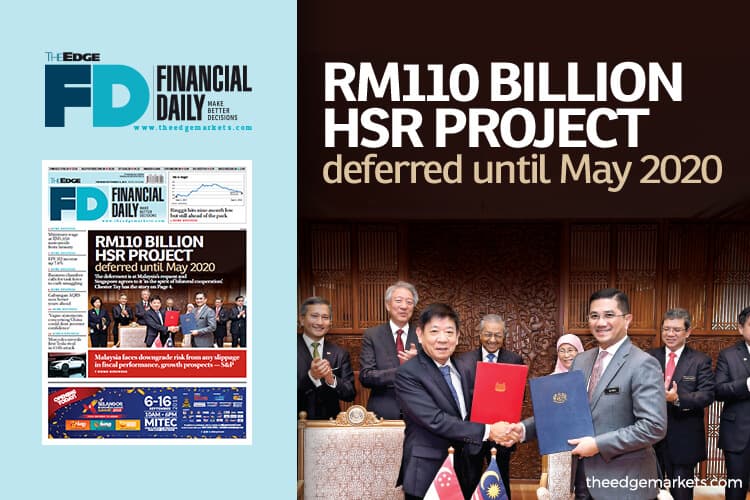
This article first appeared in The Edge Financial Daily on September 6, 2018
PUTRAJAYA: Malaysia can only defer the Kuala Lumpur-Singapore high-speed rail (HSR) project for two years to salvage the country’s strained fiscal position, but cannot abort the project that will cost a whopping RM110 billion.
Yesterday, the Malaysia and Singapore governments signed a side letter for the HSR Bilateral Agreement to defer the construction of the project until end-May 2020.
In a joint statement yesterday, both governments said they are committed to the project, but at Malaysia’s request and “in the spirit of bilateral cooperation”, Singapore has agreed to suspend the project.
For that, Malaysia has to bear a S$15 million (RM45.18 million) cost of deferment or abortive costs, and the project’s estimated date of commencement of operation will be postponed to Jan 1, 2031, instead of Dec 31, 2026 originally.
“If by May 31, 2020, Malaysia does not proceed with the HSR project, Malaysia will also bear the agreed costs incurred by Singapore in fulfilling the HSR Bilateral Agreement,” said the statement.
The agreed cost was not revealed to the press.
The Singapore government had made significant investments for the proposed HSR. For instance, it bought the decades-old Jurong Country Club in May 2015 for S$89.8 million and the Raffles Country Club last year for an undisclosed sum.
Yesterday, Singapore’s Coordinating Minister for Infrastructure and Minister for Transport Khaw Boon Wan and Malaysia’s Economic Affairs Minister Datuk Seri Mohamed Azmin Ali signed and exchanged legal documents to vary the HSR Bilateral Agreement here.
At a joint press conference, Mohamed Azmin said the abortive costs to defer the project was due end-January next year.
“Both parties met on Aug 27 and 28 to discuss details ... In the event we cancel the project, we will certainly meet and discuss, but I do not want to jump to the conclusion because the agreement signed today (yesterday) clearly states our commitment to continue with the project, after May 2020.
“I agree with Minister Khaw that if the deferment period is beyond two years, the business model would change, and the cost would continue to escalate. So based on our negotiations via various meetings, we agreed to a two-year deferment period,” Mohamed Azmin explained.
During the suspension period, Malaysia and Singapore will continue to discuss the best way forward for the HSR project with the aim of reducing costs, according to the joint statement.
This brings hope that the project might not be as pricey as the original sum.
Like a few other megaprojects, the HSR does not seem to have been received well by the new government given the high project costs.
During an interview with The Edge Malaysia weekly in May, Prime Minister Tun Dr Mahathir Mohamad commented that the terms of the agreement on the HSR are such that if Malaysia decided to drop the project, it would cost the country a lot of money.
Dr Mahathir is of the view that the HSR is not viable for such short distances. And he did not think there was a strong demand for such a rail service given that there are already different modes of transportation available across the Causeway.
Meanwhile, Finance Minister Lim Guan Eng said in a press interview in early July that the Malaysian government received offers to build the rail project at half the cost,.
The idea of building the HSR was first mooted back in February 2013 when former prime minister Datuk Seri Najib Razak and Singapore Prime Minister Lee Hsien Loong agreed to build the railway during the Singapore-Malaysia Leaders’ Retreat then.
The governments of both countries signed a bilateral agreement on Dec 13 2016, which captured the key points of agreement on the project, including the technical parameters, commercial model, customs, immigration and quarantine clearance, safety and security matters, regulatory framework and project management approach.
The HSR aims to facilitate a 90-minute travel time between Kuala Lumpur and Singapore.
According to the original plan, there would be eight stations along the track, namely the Bandar Malaysia, Sepang-Putrajaya, Seremban, Melaka, Muar, Batu Pahat and Iskandar Puteri stations in Malaysia and the Jurong East station in Singapore.